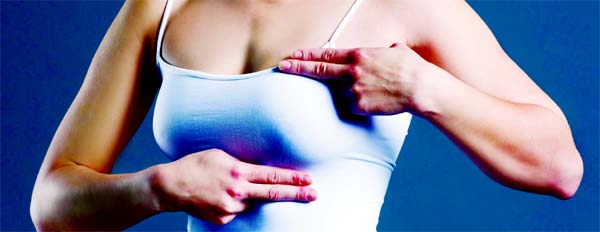
Weekend Plus Desk :
Regularly examining your breasts plays a crucial role in early detection of breast cancer, when it is more likely to get treated. Self-breast exams in combination with other screening methods can help in looking for problems like lumps, change in skin colour or any kind of discharge. Hence, if you spot anything unusual, you can seek medical assistance.
While not all changes in your breast tissue are cancerous in nature, it is better to consult your doctor for the same.
Stand in front of the mirror
You can begin the exam by taking off your top and standing in front of a large mirror. Make sure that the room is well-lit. Keep your shoulders straight and arms relaxed by your sides. Now, analyze your breasts and look for any lumps, change in size, shape or any other kind of distortion.
Check your nipples
Analyse your twins closely and look for any signs of peeling or discolouration. Spot anything that feels unusual and out of place. Squeeze your nipples lightly and check for any discharge fluid.
Check your armpits
Raise your arms and check your armpits. Look for any lumps or
Regularly examining your breasts plays a crucial role in early detection of breast cancer, when it is more likely to get treated. Self-breast exams in combination with other screening methods can help in looking for problems like lumps, change in skin colour or any kind of discharge. Hence, if you spot anything unusual, you can seek medical assistance.
While not all changes in your breast tissue are cancerous in nature, it is better to consult your doctor for the same.
Stand in front of the mirror
You can begin the exam by taking off your top and standing in front of a large mirror. Make sure that the room is well-lit. Keep your shoulders straight and arms relaxed by your sides. Now, analyze your breasts and look for any lumps, change in size, shape or any other kind of distortion.
Check your nipples
Analyse your twins closely and look for any signs of peeling or discolouration. Spot anything that feels unusual and out of place. Squeeze your nipples lightly and check for any discharge fluid.
Check your armpits
Raise your arms and check your armpits. Look for any lumps or
thickening under your arms with your fingertips in a gentle circular motion. Check both sides for comparison. Take your time and feel the whole central area, front bonder, back border and the inner border of the underarms.
Lie down for a final check
Lie down on your back and examine the breast tissue. Gently press the breast tissue using small circular motions. Make it a point to cover all of the breast tissue, from your armpit to the cleavage.
When should you do a breast examination?
The ideal time to analyze your breasts is 3 to 5 days after your menstrual cycle. This is because your twins are less likely to be swollen after your monthly cycle, making it easier and more comfortable for you to examine them. When you get into the habit of examining your twins once a month, you will immediately notice if something seems off or unusual. You can also start keeping a journal about your self-examination to keep a tab on any abnormalities or lumps that surface during a particular time every month.
A word of caution:
It is important to remember that a self-breast exam cannot replace a professional diagnosis. Always consult a medical professional for complete guidance.
Lie down on your back and examine the breast tissue. Gently press the breast tissue using small circular motions. Make it a point to cover all of the breast tissue, from your armpit to the cleavage.
When should you do a breast examination?
The ideal time to analyze your breasts is 3 to 5 days after your menstrual cycle. This is because your twins are less likely to be swollen after your monthly cycle, making it easier and more comfortable for you to examine them. When you get into the habit of examining your twins once a month, you will immediately notice if something seems off or unusual. You can also start keeping a journal about your self-examination to keep a tab on any abnormalities or lumps that surface during a particular time every month.
A word of caution:
It is important to remember that a self-breast exam cannot replace a professional diagnosis. Always consult a medical professional for complete guidance.

